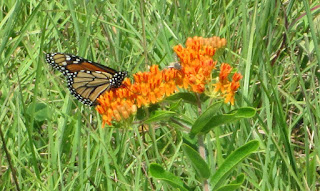Nectar – A Tasty Lure for Pollinators
By Kathy Conner Cornell
While my husband and I were having our evening beverage out on the porch, I was watching a hummingbird stick its beak into every flower on my red salvia. I know the role of pollen and the role of pollinators but it started me thinking about nectar.
This monarch butterfly is sipping nectar from this butterfly weed, a good example of how the plant lured the butterfly with nectar to assure the butterfly will pollinate the butterfly weeds.
I don’t remember studying nectar in horticulture school. Therefore, it must not serve any purpose to the plant. This is indeed the case except to attract pollinators. Almost 80% of the world’s plants are angiosperms or flowering plants. These plants require pollinators to transfer pollen from the male stamen to the female pistil in order for the plant to fertilize and make seeds. Most plants use glands at the base of the flower to make nectar. This is called floral nectar. These plants are pollinated by what we normally associate with pollinators – bees, flies, butterflies, moths and hummingbirds.
However, there is another type of nectar called extrafloral nectar (EFN). This nectar can be found on plant parts such as leaves and stems. This occurs in over 2000 plants including cherries and peaches. It attracts aggressive ants for the most part. According to University of Florida, “Two functions for the EFN have been hypothesized: as an excretory organ for the plant to rid itself of metabolic wastes or to attract beneficial insects for plant defense”. The majority of studies support the plant defense function. The bottom line from recent studies is that extrafloral nectar lures these ants and some arthropods to protect the plant from insect and vertebrate herbivores. Think of a spider chowing down on a leaf munching caterpillar.
Nectar is made of primarily of sugars, about 95%, with some amino acids and other nutrients. I know it is very sweet because I have tasted it. No, I didn’t stick my tongue down a flower. A church I used to attend had a big population of Japanese honeysuckle out back. I used to break off the end of the flower and pull the stringy thing down, which I now know was the stamen, and the drop of nectar would appear and I would lap it up. Didn’t help the pollination effort but Japanese honeysuckle really doesn’t need any help, in my opinion.
Nectar production is reduced during periods of drought. But nectar removal stimulates nectar replenishment. Nectar replenishment is also affected by the type of pollinator. Nectar would be less rich but more prolific in a plant visited by hummingbirds vs. butterflies. It should be noted that nectar ceases to be produced once fertilization is achieved.
Who knew plants are smart enough to produce a lure to assure pollination occurs. Just another fascinating thing to know about plants. The VCE Halifax Extension Office is now open. Masks and social distancing are required. If the door is locked, please knock. If you have gardening questions, you can continue to reach an Extension Master Gardener or Extension staff member by sending an email to wmccaleb@vt.edu or calling the Halifax Extension Master Gardener Help Desk at (434) 830-3383. Be sure to give us your first and last name, telephone number and the nature of the call. The Help Desk phone is routinely checked. Someone will get back to you, although it may be from a different telephone number. Make sure to get your vaccination and think about the amazing function of nectar next time you see a bee on a flower.

